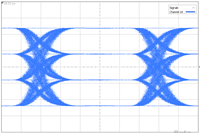Oscilloscope Mode

Viewing repetitive, random signals
In Oscilloscope mode, repetitive, random signals (PRBS) result in a waveform that appears to be an eye-diagram as shown in the following picture. However, this is not an eye diagram but is a waveform on which Oscilloscope mode measurements cannot be made. To make measurements on this signal, use pattern triggering (requires instrument N1000A-PLK or N109x-PLK).
| Without Pattern Lock | With Pattern Lock |
|---|---|

|

|
Saving waveforms to a file
To save a displayed waveform to a file, click File > Save > Waveform. You can save the waveform to a file in either internal FlexDCA format or a text/csv format.
Measuring waveforms
Oscilloscope mode measurement algorithms require a single-valued waveform and will not work with eye diagrams. Click the measurement toolbar buttons to make typical pulse measurements such as rise time, fall time, overshoot, and Vp-p. Measurement results are calculated from the most recent acquisition sweep of the active channel. All Oscilloscope mode measurements, with the exception of jitter, can be performed on any of the following sources:
- input channels
- waveform memories
- math functions
One of these sources must be turned on in order to perform a measurement. If more than one source is turned on and you initiate a measurement, the Enter Measurement Info dialog opens allowing you to select the measurement source.
You can perform up to 32 simultaneous measurements on one displayed waveform. Measurement results appear in the measurement results area. The results of up to 32 measurements can be displayed. The display also shows any measurement failures or instrument messages that occur.
When you switch between operating modes, the graticule display is cleared. If you have an active jitter measurement, and you switch between operating modes, the measurement database will also be cleared.
Once you have defined the settings you want for the measurement in the Configure Measurements dialog, these values will be applied to all subsequent measurements. The settings will remain unchanged until you redefine the measurement configuration, or recall a previously defined measurement setup with different values.